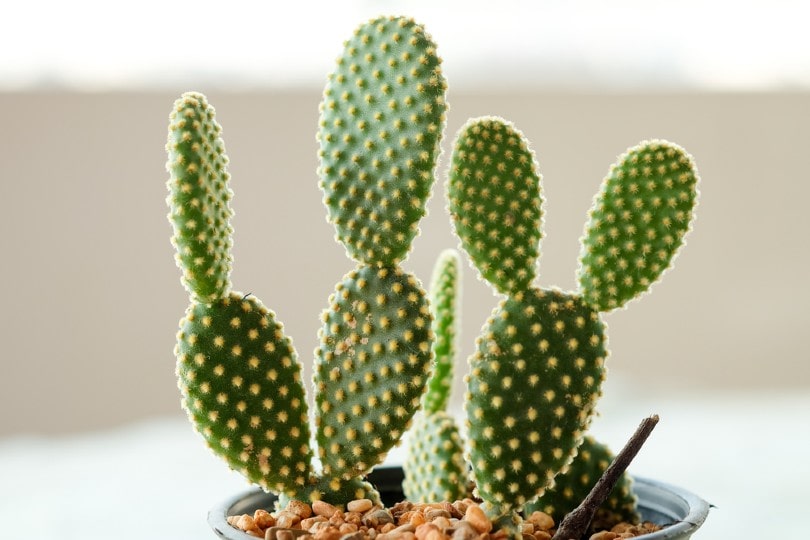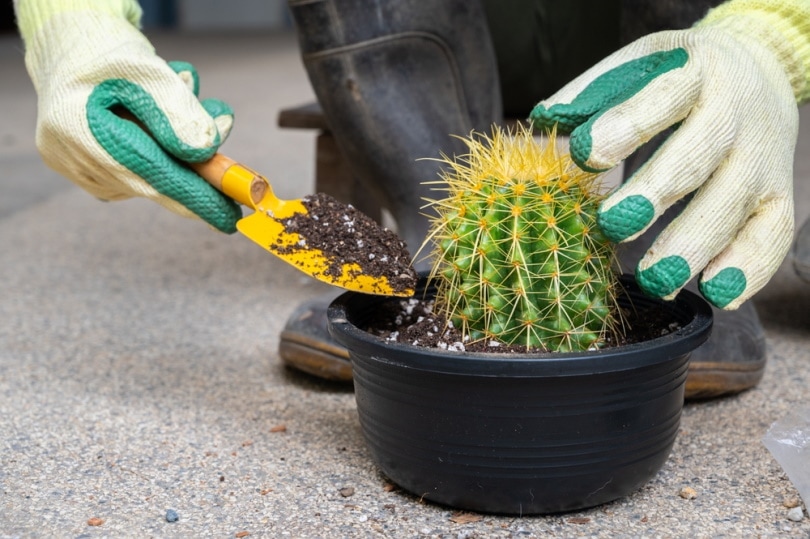Why Is My Cactus Turning Brown? 6 Possible Reasons
-
Pete Ortiz
- Last updated:

Cactus plants come in many sizes, shapes, and colors. They are a favorite of plant enthusiasts for their unusual appearance. Cactus owners also like the minimal maintenance and durability of the plants. Like other household plants, they are not exempt from problems, however. They can become damaged or diseased.
If you notice your cactus plant is turning brown, you should find the cause so you can do what is necessary to remedy the problem. Here are six possible reasons and solutions for a cactus turning brown.
The 6 Likely Reasons Your Cactus is Turning Brown
1. Overwatering
Cactus plants do not require as much water as other household plants. It is always best to under-water rather than overwater. Cactus plants are like other houseplants: if there is water, they will drink it. They are a desert plant that recognizes the importance of getting water when it is available.
If a cactus plant gets too much water, it can lead to root rot.
If your cactus plant is getting brown spots, let it dry out. Be sure that the soil is dry all the way to the bottom of the pot. The pot should not be heavy. You should only feel the weight of the plant and the pot.
Choosing the proper pot size for your plant will also help avoid overwatering. Plant the cactus in a container that is a bit larger than the ball of the plant. A pot that is too large allows the soil to hold water and moisture.

2. Insufficient Light
If your cactus plant is sitting in a sunny window but is growing toward the sunlight, it may be a sign that it is not getting the proper lighting. Before the plant shows signs of turning brown, change the position of the plant.
In some instances, the pot is positioned correctly. The plant is in a sunny window, but it is planted too far down in the pot. If the plant is several inches down, it may not be getting enough light. This situation may also limit the air circulation for the plant.
Soil gets compressed and compacted over time. This will cause your plant to sink down into the pot. We suggest that you repot the plant. Fill the pot with enough soil to reach just below a quarter of an inch of the top rim.
3. Too Much Light
If your cactus plant is in a sunny window, it may be getting too much light. This would also be the case if the window gets hot during the day.
If the cactus plant is beginning to develop spots on the tip of the plant, it may be getting sunburned. The tip may turn brown, dark yellow, dark red, or orange. It may also appear rusty in color. To remedy sun stress, move the plant to an area that receives less direct sunlight.

4. Cactus Rot
Another reason your cactus may be turning brown is root rot. If the plant is mushy and soft in the area around the brown spots, it is most likely starting to rot from the inside.
To remedy this situation, start a new plant. Cut the cactus stems off where there are no signs of rot just above and around the mushy area. This should be done with a sterilized razor blade or a sharp pair of sheers. Once the rotted part is cut off, let the healthy stems dry out and form a callous. Replant the cactus in a proper sized pot with the soil a quarter of an inch below the top of the planter.
Cutting off the healthy part of the plant is the only way to save a cactus with root rot. You can discard the rotted section of the plant.
Clean and dry the new pot thoroughly and replant the fresh (healthy part) in new soil.
5. Pests, Fungi, and Disease
Brown spots on your cactus plant can be a sign of fungus, disease, or pests. It is not unlikely for it to be all three. If the plant is not soft and mushy from root rot, test the brown spot. If it feels hard and healthy, it may be fungus. At this point, the cactus can still be saved.
Fortunately, you can prevent further brown patches with a fungicide. The scars (ugly brown spots) that are on the cactus will remain.
Brown spots forming small holes or spots resembling lesions may be a fungus caused by wet or cool conditions. The spots will not go away but they will not kill the plant either. You should monitor the plant so it does not get worse.
Another common reason for hard brown spots on a columnar cactus is a scale infestation. The hard brown spots on the plant are from the scale insects sucking the juice from the cactus.
Once you pick the scale from the spot, apply an insecticide. If you are having difficulty or cannot remove the scale, drown them. You can do this by soaking a cotton swab with 70% alcohol. Now you can scrape them off the spot.
Hard brown spots with white bumps are an indication of a mealybug infestation. They need to be removed immediately. Read on for instructions on how to rid your cactus of mealybugs.
Your cactus may be turning brown for spider mites. With spider mites, you will notice thin webbing on the cactus. Spray the mites with a mixture of half alcohol and half water.

6. Corking From Age
If the brown discoloration is on the stems or the base of the plant, your cactus may be corking from age.
Corking occurs in mature cactus plants to strengthen the stems and support the plant. It happens naturally in older plants and is not something to be concerned about.
What Are Mealybugs? How to Rid Your Cactus of the Little Pests
Mealybugs are those tiny white specks that show up on your cactus in the blink of an eye. The faster you can rid your plant of the little bugs, the better.
Mealybugs are attracted to tropical plants, succulents, and cactus plants. They are quite common houseplant pests. If left to feed off the juices of your plant, it will weaken and stunt its growth. The plant will eventually die.
Cactus plants can carry the bugs or eggs. It is important to inspect the cactus when you purchase it. A mealybug infestation can start from garden flowers or get passed on to the plant by pets and humans. The bugs are harmless to humans. They do not infest your home or bite or crawl on people.
You will know your plant has mealybugs if there are tiny fuzz balls on the plant. You will also notice that areas of the plant look wet or shiny. In some instances, there may be mold or fungus. The wet or shiny appearance is the result of the honeydew secretions from the bugs.
If the soil looks wet and you have not watered it recently, it may be an indication that the mealybugs are in the soil.

How to Rid Your Cactus of Mealybugs
A small number of mealybugs on your plant can easily be removed. You can just pick them off or scrape them off with a cotton swab dipped in 70 percent alcohol.
For several days, inspect the plant and repeat the steps if you see any on the plant. Use a clean Q-tip for each bug you remove.
A large infestation of mealybugs will require spraying the plant with a mixture of 2 percent dish soap and bottled or distilled water. Do not use tap water. The minerals are good for mealybugs.
Spray the mixture into every crack and crevice. The bugs are tiny, and you do not want to leave any behind. The soap and water should suffocate and drown the little pests.
Repeat every two days until you no longer see any mealybugs. This should take up to two weeks. Once they are gone, rinse the cactus with distilled water.
The alcohol method is quick and easy. Use this method in the morning or evening so the plant does not burn. Spray each bug with 70% alcohol. It dries them out, and they die immediately. Be cautious; you don’t want to use too much and damage the plant.
You can kill the bugs with systemic insecticide also. The juices are toxic to mealybugs and kill them from the inside out. The insecticide mixed with water acts like an antibiotic.
To rid your plant of mealybugs for good, use the soap mixture with insecticide or rubbing alcohol and insecticide. This will kill any bugs left in the soil. It would be best to replant the cactus in new soil to avoid any eggs or bugs that may be lingering.
Conclusion
In some instances, avoiding or fixing brown spots on a cactus plant is quite simple. Simply moving the plant or letting it dry out will do the trick. Sometimes brown spots are just a natural process. However, treating a cactus plant for pests or diseases is a little more involved and time-consuming. Take the time to look over your plants occasionally. If something looks off, look a little closer. You may help you prevent these problems from happening in the first place.
Featured Image Credit: abcLONG, Shutterstock
Contents



